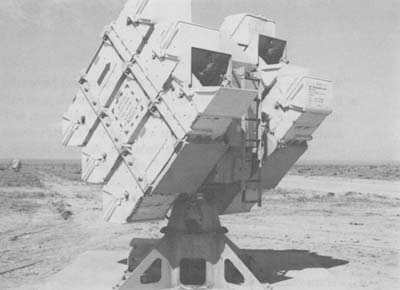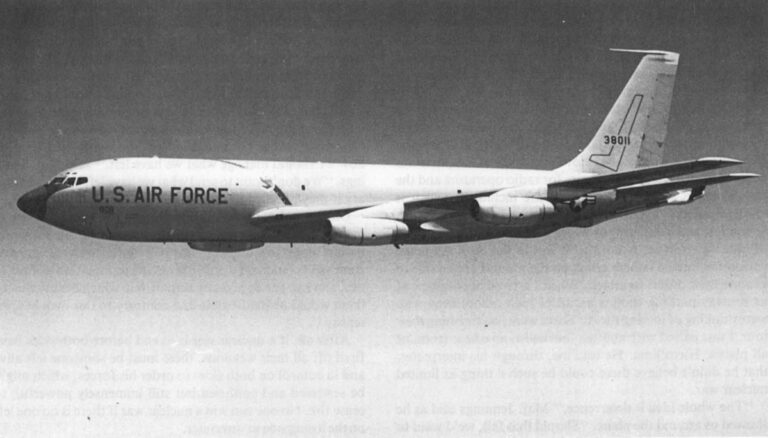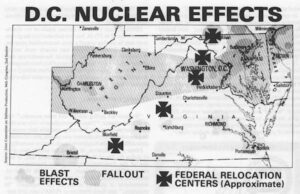
WHITE SANDS MISSILE RANGE, New Mexico–On a warm and clear autumn day in the desert the Spanish called Jornada del Muerto–the Trail of Death–the only cloud in the sky has the shape of a mushroom. Just three-and-a-half miles from the spot where the world’s first atomic bomb was tested in the final days of World War II, the Defense Nuclear Agency has detonated a mock nuclear explosion.
There is no radioactive material involved in this blast. The fuel was not plutonium but 24,790 50-pound sacks of ammonium nitrate, a common fertilizer, held together with 1000 pounds of glue and doused with diesel fuel oil. At its hottest spots, where the heat of the exploding fertilizer was augmented by flaming jets of liquid oxygen and powdered aluminum, the DNA test never exceeded 3500 degrees, compared with the millions of degrees of a nuclear blast. By treaty, this test could not be a nuclear blast. While the United States explodes real nuclear weapons at a rate of more than one a month at its underground test site in Nevada (and the Soviet Union explodes bombs underground in Central Asia), the superpowers agreed in 1963 to ban nuclear tests in the open air.
Nevertheless, this DNA test was designed to do something the underground tests cannot do. The blast it generated was equivalent to that of a one-kiloton nuclear weapon, and that blast could be used to measure the hardiness of military equipment in what military planners refer to as “the nuclear environment.” In the days before the test, the Army brought two of its brand new M-1 tanks to the site and stationed them about 1000 feet from ground zero, far enough so they would not be destroyed but near enough so they would get a nasty jolt. Nearby, the Navy erected a scale model of a deckhouse. The Federal Emergency Management Agency dug fallout shelters into the earth. The British Army clothed three dummies in nuclear war protective clothing and set them out facing the huge pile of ammonium nitrate.
Now, after the explosion, after the stacked fertilizer has disappeared and a crater 30 feet deep and 130 feet across has been blown out of the desert floor, teams of technicians are swarming over the test site checking out these and other experiments. The test structures and vehicles are off-limits to outsiders, and the results of the test will be mostly classified. But, two hours after the blast, at least one result is obvious. One of the British dummies, charred black, is still smoldering.
All of the experimenters were working, said Gen. Alan Nord, commander of the White Sands Missile Range, to observers gathered on a distant mountainside before the blast, “to gain knowledge to keep the free world free.” That knowledge would be essential in a nuclear war, but not the kind of nuclear war in which one side would destroy the other in a hail of missiles and the other side, in last minute retaliation, would return the favor. The kind of nuclear war to which the knowledge gained in the DNA test applies is a nuclear war where nuclear weapons are weapons like any others, to be used when needed, to be defended against, and to be used again another day.
Short and Cataclysmic
“We call it nuclear survivability testing,” said Armando De La Paz shortly before the explosion. De La Paz is an engineer at the Army’s Nuclear Weapons Effects Laboratory at the White Sands Missile Range, and he was at the test to monitor its effects on the M-1 tank. “We’ve been in the business since 1964,” he said, “[but] it’s only within the last three or four years that the possibility of tactical nuclear exchange was factored into the thinking….The probability that the M-1 would be involved in the tactical nuclear environment is significant, so it’s important to insure that it can carry out its functions–to move at high speed and fire with great accuracy–in that environment.”
For 28 years, the official nuclear policy of the United States has been “deterrence,” dedicated not to fighting nuclear wars but to preventing them. If the United States has enough military might to respond with a devastating blow to any attack by any enemy, the reasoning goes, then no enemy will dare to launch any attack. The fear of retaliation will have “deterred” him.
Deterrence thus emphasizes the ability to respond to an enemy attack. In the 1950s, Secretary of State John Foster Dulles spoke of “massive retaliation.” In the 1960s, Secretary of Defense Robert McNamara actually defined the levels of “assured destruction” that the United States ought to be able to inflict in response to any Soviet first-strike. The goal, he said, was one-quarter to one-third of the Soviet population killed and two-thirds of Soviet industrial capacity destroyed. (He later reduced the criteria to one-fifth to one-quarter of the population killed and half the industry destroyed.)
Such figures reinforced the image of nuclear war as short and cataclysmic that still exists in the public mind. But, for almost as long as deterrence has been around, the United States has also been producing weapons and devising strategies for another kind of nuclear war, one that more closely resembles wars of the past.
Since the 1950s, the United States has been deploying “tactical” nuclear weapons, relatively small (but still frighteningly powerful) nuclear weapons designed to be used on a battlefield. These are nuclear weapons designed less with deterrence in mind than with war-fighting. “Nuclear firepower is a form of combat firepower…” an Army field manual stated in 1968. “Plans for the employment of nuclear firepower, non-nuclear firepower, and maneuver forces are integrated to provide decisive results.”
In the 1960s, new ways to use America’s “strategic” nuclear weapons–intercontinental missiles and bombers–also began to be considered. It was conceived that a nuclear war might, at least at first, be limited to attacks on key military targets in the United States and Soviet Union. (It is another kind of “limited” nuclear war–one that is limited to Europe–that is currently causing concern on that continent.) Accordingly, new targeting options for American missiles and bombers concentrated on military targets in the Soviet Union, and efforts were undertaken to preserve the American command and control structure during a protracted nuclear war. Such planning was boosted by Secretary of Defense James Schlesinger in the mid-1970s and was formally established as Presidential policy in 1980 with Jimmy Carter’s issuance of the classified Presidential Directive 59, which was described by his Secretary of Defense, Harold Brown, as devoted to “being able to employ strategic nuclear forces selectively.” The policy was effectively reaffirmed by President Reagan in October with the announcement of his own nuclear program, which “stresses survivability and endurance” and includes plans “to communicate with [American nuclear forces] during an attack, immediately following an attack, and, if necessary, for extended periods afterwards.”
Deterrence is still invoked to explain these preparations. “The Soviet leadership appears to contemplate at least the possibility of a relatively prolonged exchange if a war comes…” said Secretary of Defense Brown after the issuance of PD-59. “We must have forces, contingency plans and command and control capabilities that will convince the Soviet leadership that no war and no course of aggression by them that led to use of nuclear weapons–on any scale of attack and at any stage of conflict–could lead to victory, however they may define victory.”
By developing those forces, plans and capabilities, however, the line between preparing to deter a nuclear war and preparing to fight one has totally disappeared.
Those Were the Days
“When we fought the war back in the early ’60s,” said Lt. Col. Paul Murphy, who was a missile launch officer in those days, “it was common to say, ‘We’ll fight our war in 10 minutes.’ Those were the days of ‘massive retaliation.’ “
These days, Murphy is assistant deputy commander for operations of the 90th Strategic Missile Wing at F.E. Warren Air Force Base in Cheyenne, Wyoming, and he says times have changed. “The President has a lot more options than he used to.”
Times have changed in many ways for the Warren base. A hundred years ago it was a cavalry post charged with protecting the Union Pacific Railroad. In 1981, it still has a polo field, but the base liquor store, reflecting the base’s new mission, is called “Ground Zero.” Warren is the command center for 200 Minuteman III intercontinental ballistic missiles scattered in small plots in a swath across the grasslands of southeastern Wyoming and adjoining areas of Colorado and Nebraska. Each of the missiles carries three nuclear warheads, and each warhead has a destructive yield of at least 170 kilotons, or 13 times the force of the bomb that was dropped on Hiroshima.
‘In order to have a credible deterrent, we have to have a credible war-fighting capability,” said Col. Robert Gifford, the wing deputy commander for operations, as he sat in his office with Lt. Col. Murphy recently and talked about the Warren missiles. “We can’t be a paper tiger. They have to believe that surviving missiles after a first strike are capable of causing them a great deal of national harm.”
Technological advances introduced into the missile silos in recent years have in fact increased their survivability and their specific war-fighting capabilities. Where the missiles were once rigidly mounted against the silo walls, they now swing cushioned in gigantic slings. The 110-ton concrete and steel doors that cap the silos have been strengthened. (“They protect the missiles from snow and rain, and also from thermonuclear blast,” explained one missile maintenance man.) Electric components in the silos have been shielded from the potentially disabling electromagnetic pulse that would accompany a nuclear blast over the United States. While the missile silos are still not immune to direct hits by nuclear warheads (it is their alleged vulnerability to new, highly accurate Soviet missiles that led to the now stalled mobile MX missile program), all of these changes have at least improved the missiles’ chances of riding out an incoming nuclear attack and still being able to function.

As for launching an attack of their own, the missiles’ targeting flexibility–and thus the President’s ability to fight a custom-made and perhaps limited nuclear war–has been greatly enhanced. “The old missiles had one warhead and two places it could go,” explained a former missile crewman at Warren. “We were considered to be a one-shot artillery piece buried in the ground. We were not responsive; it took 24 hours to change the targets. When you got an execution order, it was either target A or target B. The only other factor was timing. You’d maybe send one of your missiles 19 minutes later because you didn’t want to put it into a target that one of your bombers was going to be flying by.”
Dial-A-War
Today the computer memory in each missile contains four alternate target sets for its three warheads. In the past, to reset a missile’s two targets, new instructions had to be placed physically in the missile. Now, each missile’s twelve targets can be changed quickly and remotely from its launch control center. (Each “flight” of 10 missiles is controlled by one underground launch control center.) Such changes could be made before, during, or after a nuclear attack. “Political scientists can debate forever about what kinds of targets you should pick,” said Col. Gifford, “but you never can tell what the target base is going to look like if it should ever come time to use the missiles. We want the flexibility to go after targets that are important to the war effort we might be involved in.”
In addition, computers in the launch control centers can store up to 200 war plans. “In the old days,” said Lt. Col. Murphy, “when the launch message came in, the crew physically took action to arm specific missiles. Now it’s all prestored in the computer. If you get the message, say, to fight war number 37, you dial it up and those missiles that are supposed to go, go, and those that aren’t, don’t.”
“It gives you enhanced options,” said Col. Gifford, “and that’s the direction of PD-59, to give the NCA [National Command Authority, i.e. the President or his successor] many different options.”
“The SIOP spectrum includes everything from dropping one weapon out in the middle of nowhere to show intent, to using everything we have,” said Maj. Norwood Jennings as he showed visitors around the Looking Glass plane. The SIOP (Single Integrated Operational Plan) is the master plan for an American nuclear attack, and the Looking Glass plane is a means of last resort for making sure that attack is launched “if,” as the military says, “deterrence fails.”

Both the Joint Strategic Target Planning Staff, which draws up the SIOP, and the Looking Glass plane are based with Strategic Air Command headquarters at Offutt Air Force Base, Nebraska. The target planning staff is constantly engaged in refining the National Strategic Target List of targets in the Soviet Union that the United States would want to destroy in a nuclear war. The SIOP assigns specific targets to specific American missiles and bombers in a variety of scenarios, as Maj. Jennings indicated.
Using Up the Leftovers
Jennings serves as an operations planner aboard the Looking Glass, which is the name given to whichever one of a fleet of specially outfitted EC-135s (military versions of the Boeing 707) is currently airborne. One of the EC-135s is always airborne; there has been a Looking Glass plane flying in random patterns over the Midwest continuously since February 3, 1961. The plane’s mission is to take over command of America’s land-based ICBMs and long-range bombers if the SAC underground command post at Offutt and alternate command posts are destroyed in a nuclear attack.
The Looking Glass plane has no windows, except for the windows in the cockpit, and the flight crew can cover those with aluminized fabric curtains to shield their eyes from the glare of nuclear explosions below. The body of the plane has desks along each wall with chairs for radio operators and the eleven-person battle crew (women are included), which is always headed by a SAC general. Over the desks hang radios, computers and machinery by which the battle staff can launch Minuteman missiles from 25,000 feet in the air if for some reason the missile launch crews on the ground are unable to execute their orders to attack. When I arrived at the plane at its runway parking spot, a group of high school boys who were thinking of joining the Air Force were just finishing their tour. I was paired with another journalist, an editor from, of all places, Hiroshima. He told me, through his interpreter, that he didn’t believe there could be such a thing as limited nuclear war.

“The whole idea is deterrence,” Maj. Jennings said as he showed us around the plane. “Should that fail, we’d want to maximize our situation relative to the Soviets post-SIOP and post-war.”
In other words, America would try to win the war. And the Looking Glass plane is prepared to pick up the pieces of that effort even after a major nuclear exchange. “After an attack,” Jennings said, “we’d be trying to determine how things had gone and trying to determine where to go from here. Now that the [SIOP] plans have been executed, it’s free play from here on.”
The Looking Glass battle staff would first attempt to learn which American forces had reached their SIOP targets. “We’d try to find out what assets got off the ground, what assets are on the ground, and what assets are in the ground,” said Maj. William Stalcup, another Looking Glass crew member.
The battle staff could assume that Soviet targets assigned to American bombers and missiles that were “in the ground” remained unhit, and it would attempt to gain additional information about the status of Soviet targets from satellite reconnaissance, returning bomber crews and commanders of the American submarine missile force. Looking Glass intelligence officers would then “prioritize” unhit Soviet targets, and operations officers like Maj. Jennings would suggest a strike plan to the Looking Glass commanding general, who, with the approval of surviving National Command Authorities, would order the attack. “We’ll be trying to determine how we should manage what we have left,” said Maj. Jennings. “We don’t want to send what we have left against a granary if they have leadership targets left.”
On that point, however, Jennings may be wrong. “We recognize,” wrote former Defense Secretary Harold Brown in his last report to Congress, “the role that a surviving supreme command could and would play in the termination of hostilities, and can envisage many scenarios in which destruction of them would be inadvisable and contrary to our own best interests.”
After all, if a nuclear war is to end before both sides have fired off all their weapons, there must be someone left alive and in control on both sides to order his forces, which might be scattered and confused but still immensely powerful, to cease fire. No one can win a nuclear war if there is no one left on the losing side to surrender.
©1981 Ed Zuckerman
Ed Zuckerman, a freelance writer from New York City, is studying the plans and planning for nuclear war.






